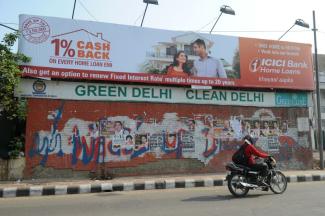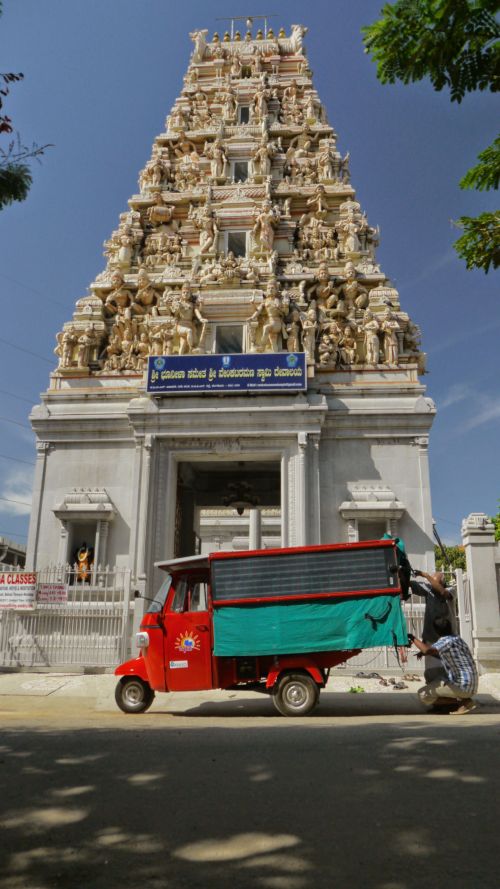German ODA
No progress without India

In the next few years, India is set to overtake China as the world’s most populous country. Its gross domestic product – at purchase power parity – is the third-largest in the world and growing fast. That can present major challenges. The country is already the world’s third-biggest greenhouse-gas emitter and likely to register by far the sharpest increases in emissions over the next two decades. At the same time, India has the largest number of people living in poverty: 400 million – as many as in all the countries of sub-Saharan Africa together.
India is also on the brink of what is probably the most massive urbanisation process in human history. Over the next 15 years, the country’s urban population will grow from 370 million to more than 510 million. By 2050, the figure will rise by a further 250 million. Around 65 million Indians currently live in appalling conditions in urban slums. At the same time, pollution levels are high and getting worse: no less than ten Indian cities are on the WHO’s list of the world’s top 20 cities with the worst air pollution.
The figures show there is no way that global challenges such as those addressed by the 2030 Agenda, the World Climate Conference or Habitat III can be resolved without India. India is still very much a developing country, well behind the likes of Brazil or South Africa. This makes development cooperation (DC) with India not just important but essential.
The fact that India is also a nuclear power, a software giant and the world’s second-largest market for smartphones – as well as having the ability to send satellites into orbit around Mars – by no means undermines the argument for DC. It is merely evident that India needs to take charge of its development and also accept international responsibility.
And that is happening. International development funds today account for just 0.1 % of India’s gross domestic product. Even more than in most other developing countries, development aid in India has mostly a qualitative impact. It does not take over whole task areas; it provides stimuli and expertise.
In the highly complex political, social and cultural environment of the Indian subcontinent, those stimuli are not “self-sellers”. For one thing, they need to be requested: India is a self-assured country and basically wants help only to support its own development priorities and major national reform programmes. The government specifically approaches partners that it considers the most competent. The German government qualifies as such in areas like energy transition, sustainable production, environmentally sound transportation and vocational training.
On the other hand, the stimuli need to be visible – both politically and in terms of outcomes. Small-scale ventures and pilot projects are generally not enough. Size matters. Several years ago, the Indian government severed ties with a number of donors and now states quite openly that it wants a minimum turnover of a billion dollars a year from each of the remaining development partners.
Germany can meet that requirement because a massive volume of market funds is leveraged in Financial Cooperation by a comparatively small volume of budget funds. As a result, pledges for India have exceeded a billion euros a year since 2013. In no other country in the world Germany mobilises nearly as much money for development. In India, it is the second-largest bilateral donor after Japan.
Political visibility is achieved by special formats – in the case of Germany and India notably by the biennial consultations at heads of government level and by the Indo-German Energy Forum that meets each year. The two main “beacons” of German DC in and with India relate to renewable energy/climate action and sustainable urban development (see box).
Focus and priorities are needed if German DC is to make a visible difference. But flexibility is also required, as well as the ability to respond swiftly to opportunities as they arise. German aid was involved, for instance, in the creation of the hospital insurance scheme RSBY (Rashtriya Swasthya Bima Yojana). Within a few years of its launch, 140 million people in low-income Indian families had access to insurance.
But there are also major areas in which official DC is not active in India. Discrimination against women, the marginalisation of large social groups such as indigenous communities or casteless people, labour and social rights – including child labour – and issues of governance are matters that will have a crucial bearing on India’s future development. At the same time, however, they are highly sensitive issues from a political and social perspective and are thus barely actively addressed by the government. Civil-society involvement is important here. India has innumerable NGOs, many of them very proficient, so good partner structures are in place. The number and financial volume of projects supported by German and international NGOs are probably greater in India than in any other country in the world. The Federal Ministry for Economic Cooperation and Development (BMZ) co-finances NGO projects and does so on a greater scale in India than anywhere else. Two examples of NGO activities that receive support funding from the BMZ:
- Terre des Hommes works with its Indian partner to improve the lives of women and girls in the textile industry in the south of India. The project encompasses medical and psychological care, training/retraining and awareness-raising. Here, Terre des Hommes is delivering services that have so far proved virtually impossible for official DC to provide. Whether that situation will change remains to be seen. The ground is currently being prepared for a political dialogue on common goals and activities between stakeholders in Tamil Nadu (government, employers, workers, NGOs) and actors in the German Textile Alliance.
- The Salesians of Don Bosco are the largest private provider of vocational training in India. They run 123 vocational schools there and currently cater for a total of 55,000 young people through the “Don Bosco Tech India” network. The Salesians are known and respected throughout the country, especially for their close cooperation with skill-training institutions. The organisation is a major interface for the reform of Indian vocational training, which Germany currently supports at the invitation of the Indian government. The aim is to create dual training opportunities for a growing number of the 15 million youngsters a year entering the labour market and provide them with the skill sets that are sought by employers. The two complement one another very well: policy advice at government DC level, on the one hand, development and improvement of vocational training centres at non-government DC level, on the other.
Unfortunately, the Indian government imposes more and more controls on NGOs, especially those working for civil and political rights. Some activities – such as direct cooperation between (international) NGOs and trade unions – are explicitly prohibited, others are sometimes seriously impeded by bureaucratic hurdles.
And yet a great deal remains possible and perfectible even in this area of DC in India. It could be expedient to modify or supplement German instruments for supporting NGOs, for instance for a sharper thematic or regional focus. A great deal could be achieved, for example, if the BMZ made additional funds available for NGOs seeking to work in areas such as women’s rights or the promotion of solar power for poor households and communities in India or South Asia as a whole.
Wolfram Klein heads the India and South Asia Division of the BMZ. The views expressed in the article are his own.
wolfram.klein@bmz.bund.de








